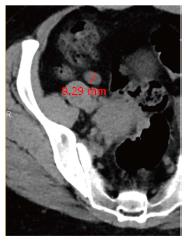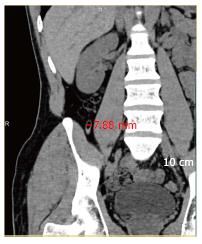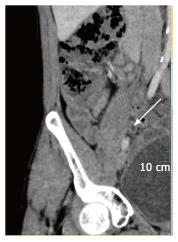Copyright
©2014 Baishideng Publishing Group Inc.
World J Radiol. Dec 28, 2014; 6(12): 913-918
Published online Dec 28, 2014. doi: 10.4329/wjr.v6.i12.913
Published online Dec 28, 2014. doi: 10.4329/wjr.v6.i12.913
Figure 1 Fifty two-year-old woman undergoing evaluation for hematuria.
Non-contrast coronal computed tomography image shows a normal appendix measuring 3.0 mm outer -to-outer wall diameter (arrow).
Figure 2 Fifty-year-old male undergoing evaluation for hematuria.
Coronal computed tomography image showing outer-to-outer wall diameter of 11.3 mm. Intra-luminal air and fluid seen in this asymptomatic patient (arrow).
Figure 3 Thirty six-year-old man undergoing evaluation for hematuria.
Axial computed tomography (CT) image showing outer-to-outer wall diameter measures 9.3 mm. A normal, but large diameter appendix with this morphology can be easily mistaken for appendicitis at CT.
Figure 4 Forty-six-year-old man evaluated for asymptomatic hematuria.
Non-contrast coronal image shows air-filled appendix measuring 7.8 mm in outer–to-ouetr wall diameter. Regardless of the diametric enlargement this morphologic appearance of appendix should always be interpreted as normal.
Figure 5 Thirty-five-year-old woman with history of asymptomatic hematuria.
Normal appendix was not visualized on non-contrast study due to fluid distended adjacent bowel and paucity of intra-abdominal fat. Above shown post intravenous contrast computed tomography of the same patient later helped identify a fluid-filled appendix of 6.0 mm diameter (arrow).
- Citation: Yaqoob J, Idris M, Alam MS, Kashif N. Can outer-to-outer diameter be used alone in diagnosing appendicitis on 128-slice MDCT? World J Radiol 2014; 6(12): 913-918
- URL: https://www.wjgnet.com/1949-8470/full/v6/i12/913.htm
- DOI: https://dx.doi.org/10.4329/wjr.v6.i12.913













